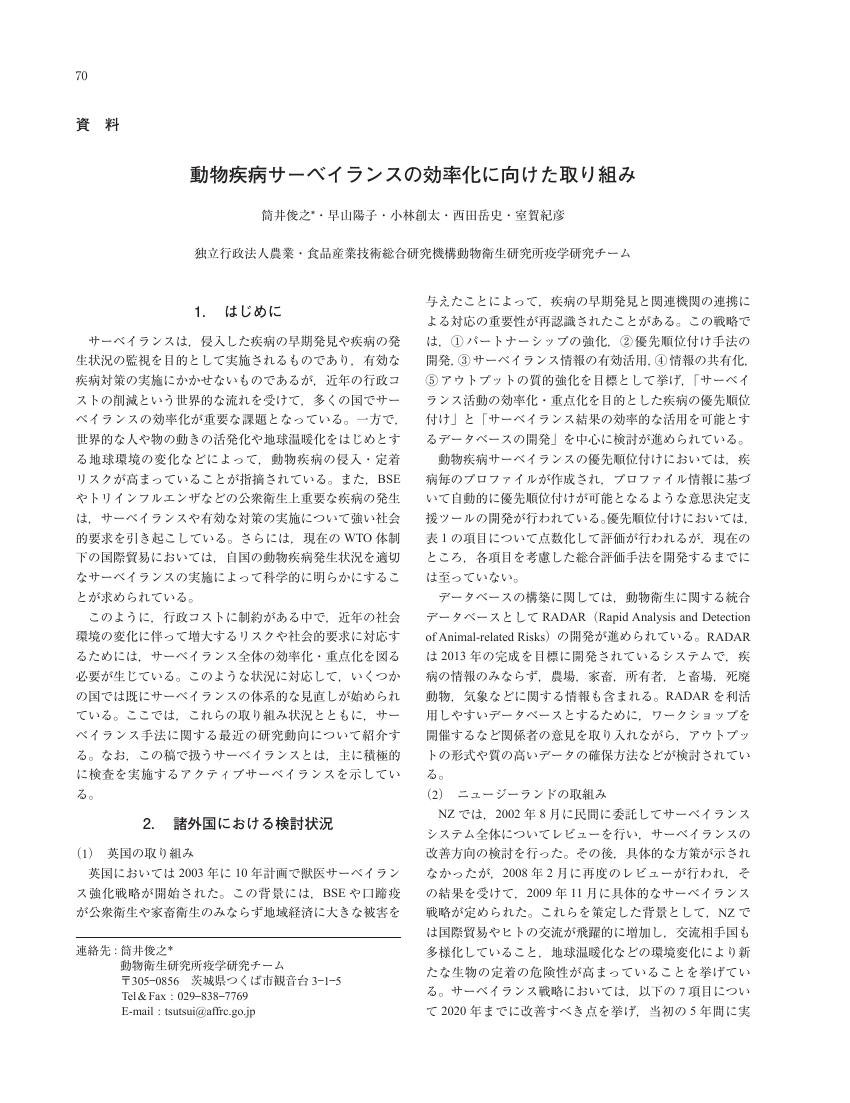69 0 0 0 OA 2010年に宮崎県で発生した口蹄疫について:
5 0 0 0 OA 動物疾病サーベイランスの効率化に向けた取り組み
2 0 0 0 OA 口蹄疫の汎用型伝播シミュレーターの開発
- 著者
- 早山 陽子 山本 健久 筒井 俊之
- 出版者
- 獣医疫学会
- 雑誌
- 獣医疫学雑誌 (ISSN:13432583)
- 巻号頁・発行日
- vol.22, no.2, pp.93-101, 2018-12-20 (Released:2019-07-01)
- 参考文献数
- 29
Foot-and-mouth disease (FMD) is a highly contagious and economically important disease of cloven-hoofed animals. Epidemiological modeling has been recognized as a useful tool for studying the spread of the disease under different environments and control measures. In this study, we developed an FMD transmission simulator (Japan simulation model of animal infectious diseases simulator FMD, JSMIN-FMD), which is a user-friendly simulation system, allowing decision makers to use for evaluation of the effectiveness and efficacy of control strategies upon the simulated outbreaks. This simulator employs a stochastic spatially explicit individual-based model to generate between-farm transmission in a selected area. To run the simulator, farm data including farm sizes, animal species, and geographical locations, is required. Parameters concerning the transmission process and control measures are also necessary. The transmission process is composed of two parts, namely transmission before the movement restrictions and that after movement restrictions. Long-distance transmissions were generated reflecting the movement of animals, humans, and vehicles in the area. The default setting parameters of these movement patterns such as the frequency and distance of movements were based on the survey results conducted in the livestock farming areas. Estimation of the movement distance is also available based on the farm density in the simulated area by a developed algorithm. Local spread was produced by transmission kernels estimated from the previous FMD epidemics in Japan in 2010 and those in Europe in 2001. Control measure scenarios include prompt culling, preemptive culling, and vaccination. For simulating these scenarios, culling or vaccinating capacities and prioritization of farms to be culled or vaccinated can be defined in advance. Simulation outputs include graphs and tables on epidemic size, economic impact, and required human resources as well as maps showing the way of the disease spread. The simulator could provide practical help for decision makers to understand how the disease spread and how best to control the disease in planning control strategies against FMD.
1 0 0 0 OA BSEとvCJDの数理疫学
1 0 0 0 OA 数理モデルを用いたエボラウイルス感染症の流行の解析
- 著者
- 山本 健久 早山 陽子 筒井 俊之
- 出版者
- 獣医疫学会
- 雑誌
- 獣医疫学雑誌 (ISSN:13432583)
- 巻号頁・発行日
- vol.19, no.1, pp.48-54, 2015-07-20 (Released:2016-01-04)
- 参考文献数
- 17
We developed a deterministic mathematical model to grasp transmission features of the large scale epidemic of Ebola virus disease (EVD) occurred in the West African region since March 2014. Basic reproduction number (R0) was estimated as 1.32, and the number of days between clinical onset and isolation into caretaking facilities was estimated as 5.0 days. If the days to isolation was less than 3.3 days, the epidemic was considered to be successfully controlled.
1 0 0 0 OA 我が国の酪農場における,ヨーネ病初摘発時の農場内浸潤度を示唆する疫学的指標(細菌学)
- 著者
- 小林 創太 筒井 俊之 山本 健久 西口 明子
- 出版者
- 社団法人日本獣医学会
- 雑誌
- The journal of veterinary medical science (ISSN:09167250)
- 巻号頁・発行日
- vol.69, no.12, pp.1255-1258, 2007-12-25
- 参考文献数
- 20
- 被引用文献数
- 11
我が国のヨーネ病摘発農場に対して全国的な疫学調査を実施し,感染農場の初摘発時におけるヨーネ病の農場内浸潤度を示唆する疫学的指標を検討した。本研究では初摘発から1年以内に感染牛が再摘発される農場では,その農場が初摘発される以前に農場内伝播が成立していると仮定し,各農場の監視期間中の追加摘発状況を観察したところ,新規に摘発された594農場のうち,158農場(27%)で再摘発が認められた.また,初摘発時の疫学情報をロジスティック回帰分析に供したところ,3つの疫学的な指標が再摘発と関連していた.すなわち,「初摘発時に発症牛がいる」,「初摘発時に複数頭摘発される」,および「牛舎形態がつなぎ飼いでない」農場は,「初摘発牛に発症牛がいない」,「初摘発頭数は1頭のみ」,および「つなぎ飼い」の農場に比べ,それぞれ3.8(95% confidence interval: 2.2,6.8),2.8(95% CI: 1.8,4.5),および2.0(95% CI: 1.1,3.6)倍再摘発されやすいことが示唆された.家畜衛生関係者にとってこれらの疫学的指標は,より集中的な防疫対策を実施するべきか否かをヨーネ病の初摘発時に判断する際の重要な指標になると思われた.
- 著者
- 山根 逸郎 筒井 俊之 志村 亀夫 濱岡 隆文
- 出版者
- 公益社団法人 日本獣医師会
- 雑誌
- 日本獣医師会雑誌 (ISSN:04466454)
- 巻号頁・発行日
- vol.60, no.9, pp.645-649, 2007-09-20 (Released:2011-06-17)
- 参考文献数
- 17
酪農家を対象にSalmonella Typhimurium (ST) による成牛型サルモネラ症の発生に関わる飼養管理要因について, 症例対照研究を応用して解析を行った. ST発生農家におけるST保菌牛割合の平均は37%(95%信頼区間; 18.4-55.8%) であった. 調査した要因のうち「飼槽の表面材質がコンクリートである」, 「餌槽と牛床間の仕切版がない」, 「連続水槽を用いている」, 「搾乳施設床面の消毒をまったく行わない」農家においてST発生のオッズ比が高かった. 今後, これらの飼養管理要因をコントロールすることにより, STによる損耗を減少させることが期待される.



